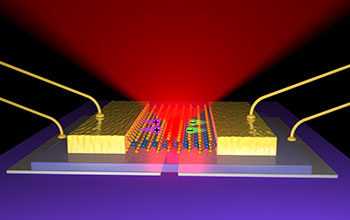Multimedia Gallery
Thinnest possible LEDs built stronger, more energy efficient
This graphical representation shows the layers of a new, 2-D light-emitting diode (LED) built by researchers at the University of Washington (UW), and how it emits light. The new LED--the thinnest known--can be used as a source of light energy in electronics. The LED is based off of 2-D, flexible semiconductors, making it possible to stack or use it in much smaller and more diverse applications than current technology allows.
LEDs are found in all types of electronics from flat-screen TVs and smartphones to wearable technologies and computer monitors. Electronic devices continue to get smaller and faster, and with them the demand for tinier, stronger and more energy efficient semiconductors.
"We are able to make the thinnest-possible LEDs, only three atoms thick yet mechanically strong. Such thin and foldable LEDs are critical for future portable and integrated electronic devices," said Xiaodong Xu, a UW assistant professor in materials science and engineering and in physics. Xu, along with Jason Ross, a UW materials science and engineering graduate student, co-authored a paper about this technology that appeared in Nature Nanotechnology. Ross is supported by a National Science Foundation graduate fellowship.
To learn more about this research, see the UW news story Scientists build thinnest-possible LEDs to be stronger, more energy efficient. (Date of Image: March 2014)
Credit: University of Washington
See other images like this on your iPhone or iPad download NSF Science Zone on the Apple App Store.
Images and other media in the National Science Foundation Multimedia Gallery are available for use in print and electronic material by NSF employees, members of the media, university staff, teachers and the general public. All media in the gallery are intended for personal, educational and nonprofit/non-commercial use only.
Images credited to the National Science Foundation, a federal agency, are in the public domain. The images were created by employees of the United States Government as part of their official duties or prepared by contractors as "works for hire" for NSF. You may freely use NSF-credited images and, at your discretion, credit NSF with a "Courtesy: National Science Foundation" notation.
Additional information about general usage can be found in Conditions.
Also Available:
Download the high-resolution TIF version of the image. (26.2 MB)
Use your mouse to right-click (Mac users may need to Ctrl-click) the link above and choose the option that will save the file or target to your computer.



